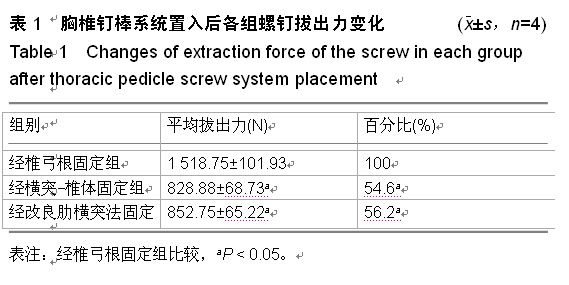| [1] 吕豪珍,林红,张绍昆,等.经伤椎椎弓根置钉技术在胸腰椎骨折中的应用[J].中国组织工程研究杂志,2012,16(9):1680-1683.
[2] 刘海波,朱宝华.伤椎椎弓根钉固定治疗胸腰椎爆裂骨折疗效分析[J].现代实用医学杂志,2014,3,201.
[3] Biedermann L. Biomecaianica of pedicle fixation as related to implant design presented lat the American-European Meeting on Pedicle of the Spine and Other Advanced techniques. Munich: Heidelberg: Springer Berlin, Germany. 1994.
[4] Dvorak M, Macdonaid S, Gurr KR, et al. Ananatomic, radiographic,and biomechanical assessment of extrapedicaular screw fixation in the thoracic spine. Spine. 1993;18:1689-1694.
[5] Vaccaro AR, Rizzolo SJ, Balderston RA, et al. Placement of Pedicle Serews in the thoracic spine.Part Ⅱ: an anatomical and Radiographic assessment. J Bone Joint Surg Am. 1995;77:1200-1206.
[6] Panjabi MM, O' Holleran JD, Crisco JJ, et al. Complexity of the Thoracic spine pedicle anatomy. Eur Spine J:1997;6:19.
[7] George DC, Krag MH, Johnson CC, et al. Hole preparation techniques for transpedicle screws. Effeet on pull-out strength from human cadaveric vertebrae. Spine. 1991;16:181-184.
[8] Willett K, Hearn TC, Cuneins AV, et al. Biomeehanical testing of a new desing for schanz pedicle serews. J Orthop Trauma. 1993;7:375.
[9] Liljenqvist UR, Alkemper T, Haekenberg L, et al. Analysis of vertebral morphology in idiopathic scoliosis with use of magnetic resonance imaging and multiplanar reconstruetion. J Bone Joint Surg Am. 2002;84A:359-368.
[10] Dvorak M, MacDonald S, Gurr KR, et al. Ananatomic, radiographic, and biomehancial assessment of extrapedieular serew fixation in the thoracic spine. Spine. 1993;18:1698- 1694.
[11] Suk SI, Lee CK, Kim WJ, et al. Segmental pedicle serew fixation in the treatment of thoracic idiopathic scoliosis. Spine. 1995;20:1399-1405.
[12] Suk SI, Kim WJ, Lee SM, et al, Thoracic Pedicle serew fixation in spinal deformities: are they really safe? Spine. 2001;26:2049-2057.
[13] 官众,许勇,任磊,等.经肋椎关节手术入路治疗胸椎多椎体结核的临床研究[J].脊柱外科杂志,2013,11(6):337-340.
[14] Morgenstern W, Merola A. Extrapedicular serew placement in the thoracic spine: a cadaverie study. Presented at: proceedings of the international meeting of advanced spine techniques. 1999.
[15] WiIke HJ, Krisehak S, Claes LE. Formalin fixation strongly Influences biomeehanical propdrties of the spine. J Biomech. 1996;29:1629.
[16] 王洪伟,李长青,周跃,等.用于脊柱内固定器生物力学评价的牛脊椎A型骨折模型的建立[J].第三军医大学学报,32(18):1967- 1969.
[17] 王新伟,陈德玉,鲍达,等.小牛胸椎解剖、生物力学研究及其临床意义[J].脊柱外科杂志,2003,1(4):223-225.
[18] 李禾,邢更彦,杨传铎,等.脊柱内固定系统生物力学研究与临床应用[J].中国修复重建外科杂志,2008,22(8):923.
[19] 丁晓琳,牟宗玲,张玲,等.利用成年猪脊柱制作胸腰段后凸畸形模型进行脊柱三围运动实验[J].中国矫形外科杂志,2012,20(5): 451-455.
[20] Yu BS. Biomechical comparison of the posterolateral fusion and posterior lumber interbody fusion using pedicle screw fixationg system for anstable lumbar spine. Hoklcaido lqaka Zasshi. 2003;78(3):211-218.
[21] Smit TH. The use of a quadruped as an in vivo model for the study of the spine-biomech anical considerations. Eur Spine J. 2002;1(2):137-144.
[22] Wilke HJ, Krischak S, Claes L. Biomechanical comparison of calf ang human Spine. J Orthop Res. 1996;14(3):500-503.
[23] Wilke HJ, Krischak ST, Wenger KH, et al. Load-displaeemental properties of the thoracolubar calf spine: experimental results and comparison to known human data. Spine. 1996;21:1957.
[24] WiIke HJ, Krisehak ST, Claes L. Biomechanical comparison of calf and human spines. J Orthop Res. 1996;14:500.
[25] Wang JL, Parnianpour M, Engin AE. Viscoelastic finite-element analysis of a lumbar motion segment in combined combined compression and sagittal flexion. Spine. 1999;24:2475.
[26] WiIke HJ, Wenger K, Claes L. Testing criteria for spinal implants:recommendations for the standardization of invitro stability testing of spinal implants. J Eur Spine. 1998;7:148.
[27] 朱青安,吕维加,王柏川,等.改进型E面ards器械固定不稳定胸腰椎骨折的生物力学评价[J].中华骨科杂志,2001,21(7):394.
[28] Kettler A, Wilke HJ, Haid C, et al. Effeets of specimen length on the monsegmental motion behavior of the lumbar. Spine. 2000;25:543.
[29] Wilke HJ, Jungkunz B, Wenger K, et al. Spinal segment range of motion as a function of invitro test conditions; effeets of exposure Period, accumulated cycles, angular-deformationrate, and moisture condition. Anat Rec. 1998;251:15.
中国组织工程研究杂志出版内容重点:人工关节;骨植入物;脊柱;骨折;内固定;数字化骨科;组织工程
|


.jpg)
.jpg)